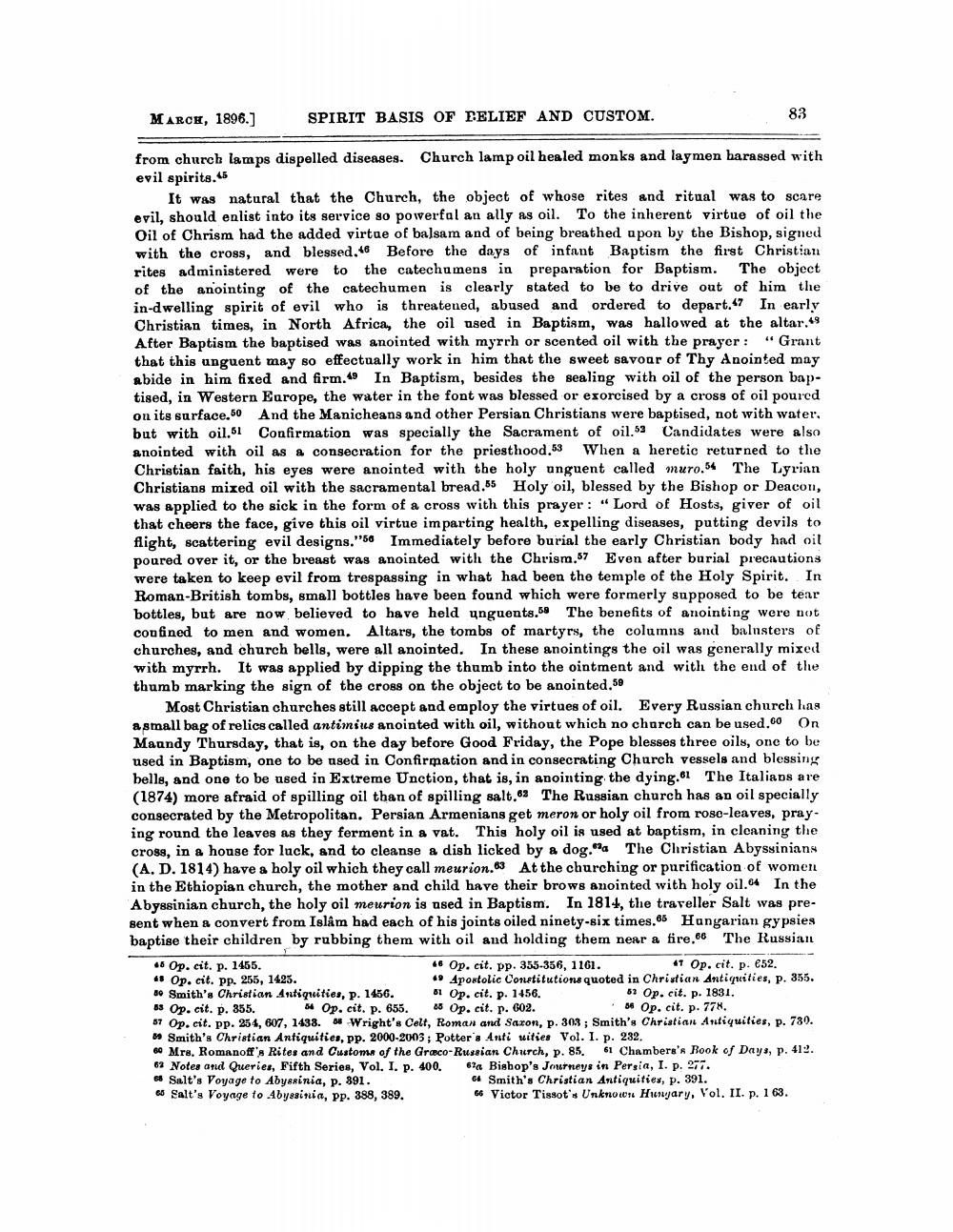________________
MARCE, 1896.]
SPIRIT BASIS OF BELIEF AND CUSTOM.
83
from church lamps dispelled diseases. Church lamp oil healed monks and lay men harassed with evil spirits.
It was natural that the Church, the object of whose rites and ritual was to scare evil, should enlist into its service so powerful an ally as oil. To the inherent virtue of oil the Oil of Chrism had the added virtue of balsam and of being breathed upon by the Bishop, signed with the cross, and blessed.46 Before the days of infant Baptism the first Christian rites administered were to the catechumens in preparation for Baptism. The object of the anointing of the catechumen is clearly stated to be to drive out of him the in-dwelling spirit of evil who is threatened, abused and ordered to depart.7 In early Christian times, in North Africa, the oil used in Baptism, was hallowed at the altar.49 After Baptism the baptised was anointed with myrrh or scented oil with the prayer: “Grant that this unguent may so effectually work in him that the sweet savour of Thy Anointed may abide in him fixed and firm.49 In Baptism, besides the sealing with oil of the person baptised, in Western Europe, the water in the font was blessed or exorcised by a cross of oil poured on its surface.50 And the Manicheans and other Persian Christians were baptised, not with water, but with oil.51 Confirmation was specially the Sacrament of oil.52 Candidates were also anointed with oil as a consecration for the priesthood.53 When a heretic returned to the Christian faith, his eyes were anointed with the holy unguent called muro,54 The Lyrian Christians mixed oil with the sacramental bread.55 Holy oil, blessed by the Bishop or Deacon, was applied to the sick in the form of a cross with this prayer: “Lord of Hosts, giver of oil that cheers the face, give this oil virtue imparting health, expelling diseases, putting devils to flight, scattering evil designs."56 Immediately before burial the early Christian body had oil poured over it, or the breast was anointed with the Chrism.57 Even after burial precautions were taken to keep evil from trespassing in what had been the temple of the Holy Spirit. In Roman-British tombs, small bottles have been found which were formerly supposed to be tear bottles, but are now believed to have held unguents.58 The benefits of anointing were not confined to men and women. Altars, the tombs of martyrs, the columns and balusters of churches, and church bells, were all anointed. In these anointings the oil was generally mixed with myrrh. It was applied by dipping the thumb into the ointment and with the end of the thumb marking the sign of the cross on the object to be anointed.50
Most Christian churches still accept and employ the virtues of oil. Every Russian church has a small bag of relics called antimius anointed with oil, without which no church can be used.co On Maundy Thursday, that is, on the day before Good Friday, the Pope blesses three oils, one to be used in Baptism, one to be used in Confirmation and in consecrating Church vessels and blessing bells, and one to be used in Extreme Unction, that is, in anointing the dying. The Italians are (1874) more afraid of spilling oil than of spilling salt.62 The Russian church has an oil specially consecrated by the Metropolitan. Persian Armenians get meron or holy oil from rose-leaves, praying round the leaves as they ferment in a vat. This holy oil is used at baptism, in cleaning the cross, in a house for luck, and to cleanse & dish licked by a dog." The Christian Abyssinians (A.D. 1814) have a holy oil which they call meurion. At the churching or purification of women in the Ethiopian church, the mother and child have their brows anointed with holy oil. In the Abyssinian church, the holy oil meurion is ased in Baptism. In 1814, the traveller Salt was present when a convert from Islâm had each of his joints oiled ninety-six times.86 Hungarian gypsies baptise their children by rubbing them with oil and holding them near a fire.66 The Russian *6 Op. cit. p. 1455.
*6 Op. cit. pp. 355-356, 1161.
41 Op. cit. p. 652. #Op. cit. pp. 255, 1423.
" Apostolic Constitutions quoted in Christian Antiquities, p. 355. Smith's Christian Antiquities, p. 1456. 1 Op. cit. p. 1456.
63 Op. cit. p. 1831. 65 Op. cit. p. 855. Op. cit. p. 655. 05 Op. cit. p. 602.
06 Op. cit. p. 778. 57 Op. cit. pp. 254, 607, 1438.68 Wright's Celt, Roman and Saxon, p. 303 ; Smith's Christian Antiquities, p. 780.
Smith's Christian Antiquities, pp. 2000-2003; Potter's Anti uities Vol. I. p. 232. 60 Mrs. Romanoff, Rites and Customs of the Graco-Russian Church, p. 85. 61 Chambers's Book of Days, p. 412. 62 Notes and Queries, Fifth Series, Vol. I. p. 400. a Bishop's Journeys in Persia, I. p. 277. 6. Salt's Voyage to Abyssinia, p. 891.
« Smith's Christian Antiquities, p. 391. 6 Salt's Voyage to Abyssinia, pp. 388, 389.
66 Victor Tissot's Unknown Huyary, Vol. II. p. 1 63.




